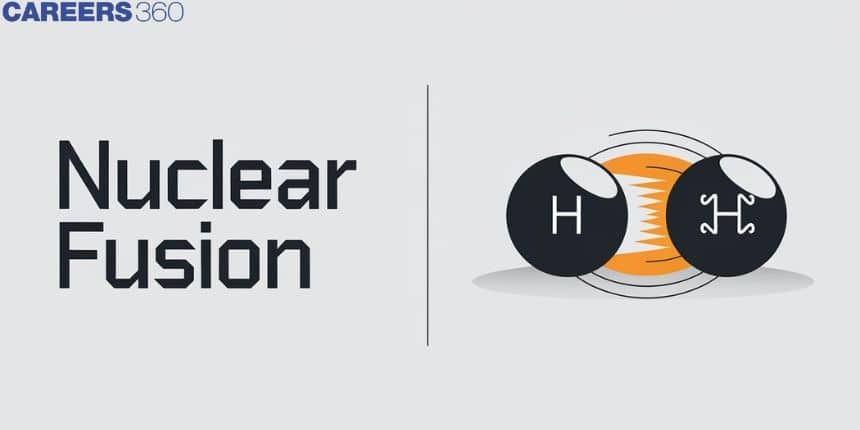Nuclear Fusion
Nuclear fusion is the process where atomic nuclei combine to form a heavier nucleus, releasing a tremendous amount of energy in the process. This reaction powers the stars, including our sun, as hydrogen nuclei fuse to create helium, releasing energy that sustains stellar luminosity and heat. On Earth, nuclear fusion holds promise for a nearly limitless and clean energy source, as it produces minimal radioactive waste compared to fission. Researchers are working on harnessing fusion for energy production, as seen in experimental reactors like ITER. If successful, nuclear fusion could revolutionize energy production, offering a sustainable solution to global energy needs and significantly reducing our reliance on fossil fuels. In this article, we are going to study about nuclear fusion and its condition also see some solved example based on this concept.
This Story also Contains
- What is Nuclear Fusion?
- The Conditions Required for Nuclear Fusion
- Solved Examples Based on Nuclear Fusion
- Summary

What is Nuclear Fusion?
Nuclear fusion is a process in which two light atomic nuclei combine to form a heavier nucleus, releasing a substantial amount of energy. This reaction occurs when the nuclei overcome their electrostatic repulsion and fuse together, resulting in a new, more massive nucleus and the release of energy due to the difference in mass between the initial and final states.
In nuclear fusion, two (or) more than two lighter nuclei combine/fuse to form a larger nucleus. In this process, energy is released.
Some examples of nuclear fusion:
Here two protons combine to form a deuteron and a positron releasing 0.42 MeV of energy.
Here two deuterons combine to form the light isotope of Helium releasing 3.27 MeV of energy.
In this case, two deuterons combine to form a triton and a proton releasing 4.03 MeV of energy.
Here mass of a single nucleus so formed is less than the sum of the mass of the parent nuclei. This mass difference appears in the form of the release of energy.
The Conditions Required for Nuclear Fusion
For the fusion to occur, two nuclei must come close enough so that attractive short-range nuclear force is able to affect them. But since both are positively charged particles, they experience coulomb's repulsion force. Therefore they must have enough energy to overcome this repulsion. For this, a high pressure of 106 atm & temperature of 109 K is required.
When the fusion is achieved by raising the temperature of the system, so that particles have enough kinetic energy to overcome the coulomb's repulsion force, it is called thermonuclear fusion.
Recommended Topic Video
Solved Examples Based on Nuclear Fusion
Example 1: When two deuterium nuclei fuse in addition to tritium, we get a
1) proton
2) alpha-particle
3) neutron
4) deuteron
Solution:
The fusion reaction of two deuterium nuclei is
Hence, in this reaction besides a tritium, we get a proton.
Hence, the answer is the option (1).
Example 2: Nuclear fusion and fission can be explained based on-
1) Binding energy per nucleon variation with nucleon number
2) Variation of mass with increasing atomic nucleus
3) Conversion of energy principle
4) Einstein's mass-energy equivalence relation
Solution:
Nuclear Fission and Fusion are processes in which mass is converted into energy. Hence, nuclear fission and fusion can be explained based on Einstein's mass-energy equivalence relation.
Hence, the answer is the option (4).
Example 3: The Sun releases energy coming from
1) Weak nuclear force
2) Strong nuclear force
3) Gravitational force
4) Electromagnetic force
Solution:
The sun generates energy from a process called nuclear fusion. During nuclear fusion, the high pressure and temperature in the sun's core cause nuclei to separate from their electrons. Hydrogen nuclei fuse to form one helium atom. During the fusion process, radiant energy is released.
Hence, the answer is the option (2).
Example 4: If a star converts all helium in its core to oxygen, then the energy released per oxygen nucleus is: (Mass of
1) 10.24 MeV
2) 5 MeV
3) 7.56 MeV
4) 23.9 MeV
Solution:
When four He nuclei are fused together, one oxygen nucleus is formed. The reaction is
Mass defect,
Equivalent energy,
Hence, the answer is the option (1).
Example 5: When
1)
2)
3)
4)
Solution:
Hence, the answer is the option (4).
Summary
Nuclear fusion is the process where light atomic nuclei combine to form a heavier nucleus, releasing substantial energy. This reaction, which powers stars like the Sun, requires extremely high temperatures and pressures to overcome electrostatic repulsion between nuclei. Fusion reactions, such as those involving deuterium and tritium, are of significant interest for sustainable energy production due to their potential for minimal radioactive waste